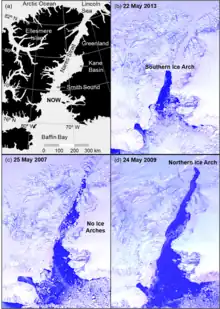Last Ice Area
The Last Ice Area is broadly the large interior polar region of the Arctic Circle covering an area between the northern edge of Greenland and the Canadian Arctic Archipelago and is the most northerly coastal zone of the world.[1] Being in a permafrost landscape, it is the oldest and thickest ice sheet in the Arctic and is expected to persist longest as a sea ice.[2] Towards the northern side, it consists of the Tuvaijuittuq Marine Protected Area, which is the largest protected area in Canada and among the largest protected areas in the world.[3] It is one of the major centres of environmental concerns that is bound to have global impact. The Arctic Council's 2017 report Snow, Water, Ice and Permafrost. Summary for Policy-makers predicted that current rate of climate change will cause the complete disappearance of the ice within a century.[4][5]

Geography and conservation
The Last Ice Area covers the central area of the Arctic Circle, thereby representing the most northerly coastal zone of the world.[1] It is so named because of its old and thick ice sheet which is expected to last the longest as a sea ice in the Arctic.[2] The northern side falling under the Government of Canada is declared the Tuvaijuittuq Marine Protected Area, the largest protected area in Canada.[3] Due to its environmental concerns and ecological impact it can have, a number of areas are proposed for protection, including Tallurutiup Imanga National Conservation Area, Pikialasorsuaq, and Nunavut protected areas.[6]
Ecology
The Last Ice Area is a natural habitat to endemic animals including bowhead whales, polar bear, Peary caribou, and muskoxen. Walrus, narwhal, and beluga whales are also living here.[7]
Environmental concerns
Arctic sea ice has been monitored by satellites since 1979,[8] and has been recorded to be melting away every decade.[9][10] The ice sheets are becoming thinner and younger, indicating increasing fragility.[11] The major threats are emissions from greenhouse gases and fossil fuels that are primary causes of global warming.[12][13] Indicators of severe climate changes such as shifting of algal blooms and ecosystem disturnaces have been recorded.[14] The A computational study in 2021 showed that the Last Ice area may retain its year-round sea ice if the global warming does not exceed a threshold (2°C of the preindustrial average global temperature).[2] However, the United Nations had warned in its Emissions Gap Report 2021 that under the current trend of emission from fossil fuels and greenhouse gases, global warming will increase by 2.7°C by 2100.[13] This has set an alarming environmental issue that life on the ice will eventually perish, from planktons to polar bears.[12]
References
- Vincent, Warwick F.; Mueller, Derek (2020). "Witnessing ice habitat collapse in the Arctic". Science. 370 (6520): 1031–1032. Bibcode:2020Sci...370.1031V. doi:10.1126/science.abe4491. ISSN 0036-8075. PMID 33243873. S2CID 227171547.
- Newton, Robert; Pfirman, Stephanie; Tremblay, L. Bruno; DeRepentigny, Patricia (2021). "Defining the "Ice Shed" of the Arctic Ocean's Last Ice Area and Its Future Evolution". Earth's Future. 9 (9): e2021EF001988. Bibcode:2021EaFut...901988N. doi:10.1029/2021EF001988. ISSN 2328-4277. S2CID 239150777.
- Government of Canada, Fisheries and Oceans Canada (2019-09-18). "Tuvaijuittuq Marine Protected Area (MPA)". www.dfo-mpo.gc.ca. Retrieved 2021-12-05.
- "Snow, Water, Ice and Permafrost. Summary for Policy-makers". Arctic Monitoring and Assessment Programme (AMAP). 2017-04-25. Retrieved 2021-12-05.
- WWF (2017-04-25). "Changed Arctic, changed world". arcticwwf.org. Retrieved 2021-12-05.
- WWF (2021). "The Last Ice Area". arcticwwf.org. Retrieved 2021-12-05.
- WWF (2010). "Last Ice Area Factsheet". arcticwwf.org. Retrieved 2021-12-05.
- WWF (2014). "Last Ice Area Biophysical Reader". arcticwwf.org. p. 27. Retrieved 2021-12-05.
- Overpeck, Jonathan T.; Sturm, Matthew; Francis, Jennifer A.; Perovich, Donald K.; Serreze, Mark C.; Benner, Ronald; Carmack, Eddy C.; Chapin, F. Stuart; Gerlach, S. Craig; Hamilton, Lawrence C.; Hinzman, Larry D. (2005). "Arctic system on trajectory to new, seasonally ice-free state". Eos, Transactions American Geophysical Union. 86 (34): 309–313. Bibcode:2005EOSTr..86..309O. doi:10.1029/2005EO340001. ISSN 2324-9250.
- Perovich, Donald K.; Polashenski, Christopher (2012). "Albedo evolution of seasonal Arctic sea ice". Geophysical Research Letters. 39 (8). Bibcode:2012GeoRL..39.8501P. doi:10.1029/2012GL051432. ISSN 1944-8007. S2CID 41193464.
- Kwok, R.; Rothrock, D. A. (2009-08-16). "Decline in Arctic sea ice thickness from submarine and ICESat records: 1958-2008: ARCTIC SEA ICE THICKNESS". Geophysical Research Letters. 36 (15): n/a. doi:10.1029/2009GL039035. S2CID 55460004.
- Kreier, Freda (2021-11-15). "Scientists are racing to save the Last Ice Area, an Arctic Noah's Ark". Science News. Retrieved 2021-12-05.
- Gramling, Carolyn (2021-10-26). "Earth will blow past climate targets even with current pledges to cut emissions". Science News. Retrieved 2021-12-05.
- Wassmann, Paul; Duarte, Carlos M.; Agustí, Susana; Sejr, Mikael K. (2011). "Footprints of climate change in the Arctic marine ecosystem". Global Change Biology. 17 (2): 1235–1249. Bibcode:2011GCBio..17.1235W. doi:10.1111/j.1365-2486.2010.02311.x. ISSN 1365-2486. S2CID 82541620.